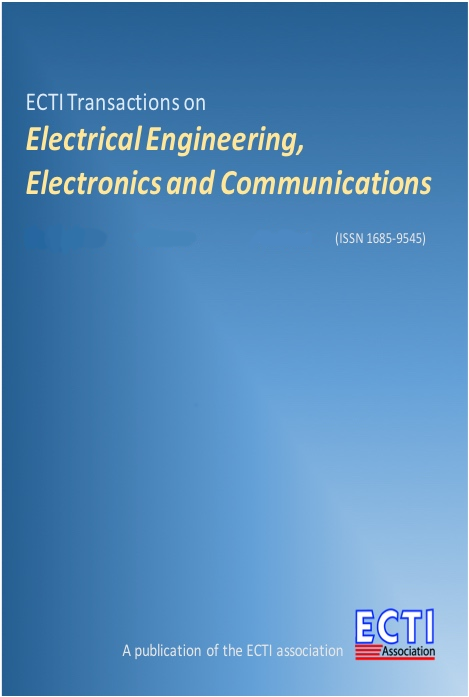A Study of a Competitive Reinforcement Learning Approach for Joint Spatial Division and Multiplexing in Massive MIMO
Main Article Content
Abstract
Massive Multiple-Input Multiple-Output (MIMO) is widely considered a pivotal communication technology for future generations of wireless networks. Massive MIMO uses a large number of antennas at the base station, which offers better effectiveness in spectral and energy use. However, a Frequency Division Duplex (FDD) system is challenging in reciprocity since it is difficult to estimate channels and requires feeding back channel state information. Joint Spatial Division and Multiplexing (JSDM) is a simplified FDD technique to provide massive MIMO gains. The main idea of JSDM is related to grouping users with approximately similar channel covariance. Many machine learning algorithms have been applied to conduct user grouping. In this paper, to improve the user grouping, we employ Reinforcement Guided Competitive Learning (RGCL) to the user grouping and then compare it with clustering techniques, including K-means, and sequential K-means to achieve the appropriate user grouping. The experimental results show that the RGCL technique represents better performance in computational time and system throughput than the other two above mentioned techniques, since RGCL can avoid being trapping in local minima.
Article Details
This journal provides immediate open access to its content on the principle that making research freely available to the public supports a greater global exchange of knowledge.
- Creative Commons Copyright License
The journal allows readers to download and share all published articles as long as they properly cite such articles; however, they cannot change them or use them commercially. This is classified as CC BY-NC-ND for the creative commons license.
- Retention of Copyright and Publishing Rights
The journal allows the authors of the published articles to hold copyrights and publishing rights without restrictions.
References
[2] Shannon, Claude E., “Channels with Side Information at the Transmitter”. IBM Corp., 2, (4), pp. 289-293, 1958
[3] Cox, Christopher, “An introduction to LTE: LTE, LTE-advanced, SAE and 4G mobile communications”. IJohn Wiley & Sons, 2012
[4]Dahlman, Erik and Parkvall, Stefan and Skold,Johan., “4G: LTE/LTE-Advanced for Mobile Broadband”. Academic press, 2013
[5]Sesia, Stefania and Toufik, Issam and Baker, Matthew.,“LTE: the UMTS long term evolution”. Wiley Online Library. 2009
[6]Wang, Zhaocheng and Stirling-Gallacher, RA., “Frequency reuse scheme for cellular OFDM systems”. Electronics Letters. 38, (8), pp. 387-388, 2002
[7] L´opez-P´erez, David and Juttner, A and Zhang, Jie,“Dynamic frequency planning versus frequency reuse schemes in OFDMA networks”. IEEE, pp. 1-5, 2009
[8] Singh, Satinder and Bertsekas, Dimitri., “Reinforcement learning for dynamic channel allocation in cellular telephone systems”. Citeseer, pp. 974-980, 1997
[9] Lilith, Nimrod and Dogancay, Kutluyil., “Distributed reduced-state SARSA algorithm for dynamic channel allocation in cellular networks featuring traffic mobility”. IEEE, 2, pp. 860-865, 2005
[10]Bernardo, Francisco and Agust´ı, Ram´on and P´erez-Romero, Jordi and Sallent, Oriol., “Intercell Interference Management in OFDMA Networks: A D ecentralized Approach Based on Reinforcement Learning”. 41,(6), pp. 968-976, 2011
[11] Kumar, D and Kanagaraj, NN and Srilakshmi, R. Harmonized, “Q-Learning for radio resource management in LTE based networks”. IEEE, pp. 1-8, 2013
[12] Foschini, Gerard J.,“Layered Space-Time Architecture for Wireless Communication in a Fading Environment When Using Multi-Element Antennas”. Alcatel-Lucent, 1,(2), pp. 41-59, 1996
[13]Marzetta, T.L.,“Noncooperative Cellular Wireless with Unlimited Numbers of Base Station Antennas”. Wireless Communications, 9,(11), pp. 3590-3600, 2010
[14] Hoydis, Jakob and Ten Brink, Stephan and Debbah, M´erouane., “Massive MIMO: How Many Antennas Do We Need?”. Communication, Control, and Computing (Allerton), pp. 545-550, 2011
[15]Larsson, E. and Edfors, O. and Tufvesson, F. and Marzetta, T., “Massive MIMO for Next Generation Wireless Systems”. Communications Magazine, 52,(2), pp. 186-195, 2014
[16]Rusek, Fredrik and Persson, Daniel and Lau, Buon Kiong and Larsson, Erik G and Marzetta, Thomas L and Edfors, Ove and Tufvesson, Fredrik., “Scaling Up MIMO: Opportunities and Challenges with Very Large Arrays”. Signal Processing Magazine, 30,(1), pp. 40-60, 2013
[17] Lu Lu and Li, G.Y. and Swindlehurst, A.L. and Ashikhmin, A. and Rui Zhang.,“An Overview of Massive MIMO: Benefits and Challenges”. Se
lected Topics in Signal Processing, 8,5, pp.742758, 2014
[18]Adhikary, Ansuman and Nam, Junyoung and Ahn, Jae-Young and Caire, Giuseppe.,“Joint Spatial Division and Multiplexing-The Large Scale Array Regime”. Information Theory, 59,(10), pp.6441-6463, 2013
[19]Junyoung Nam and Adhikary, A. and JaeYoung Ahn and Caire, G., “Joint Spatial Division and Multiplexing: Opportunistic Beamforming, User Grouping and Simplified Downlink Scheduling”. Selected Topics in Signal Processing, 8,(5), pp.876-890, 2014
[20] Likas, Aristidis.,“A Reinforcement Learning Approach to Online Clustering”. MIT Press, 11,(8), pp.1915-1932, 1999
[21]Duda, Richard O and Hart, Peter E and Stork, David G.,“”Pattern Classification”. John Wiley & Sons, 2012
[22] Sutton, R. S., Barto, A. G.,“Reinforcement learning: An introduction”. MIT press, 2018


